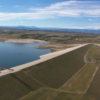Overview
The Gilboa Dam is located at the Schoharie Reservoir in the Catskill Mountains of New York State – approximately 110 miles northwest of New York City. It was the fourteenth reservoir to be created in a series of nineteen, in order to supply water to the City of New York – and is one of two reservoirs located in this area.
The City of New York purchased the town of Gilboa and the outlying areas in the early 1920’s. The existing town was relocated and the area specific to the dam was prepared for construction of the dam. The dam was completed and put into service in 1926, supplying 9M people with approximately 16% of their annual water requirements. Although the Schoharie is considered one of the smallest reservoirs utilized by the City of New York, its basin is six miles long and holds 17.6B gallons at full capacity. The water from this reservoir flows over 119 miles through the Shandaken Tunnel, into the Esopus Creek and down the Esopus, into the Ashokan Reservoir, finally entering the Catskill Aqueduct to the Kensico Reservoir and then to New York City.
Over the years, the dam has been upgraded to New York safety standards. The last upgrade consisted of a $24M project, completed in 2006, which included resurfacing the face of the dam and installing 80 anchoring cables to pin the dam to the bedrock. A full-scale reconstruction project estimated at $315M is planned for 2008. Included in this project will be the installation of floodgates, as well as an increase in the size of the dam. The project will also include the creation of a tunnel bypass so water can be safely released from the reservoir to the Schoharie Creek – the original source of water for the reservoir.
What We Did
The recent safety improvement project included installation of several extensometers to monitor the movement of the dam face relative to the bedrock. This movement data must be monitored locally during installation of anchoring cables as well as for the future reconstruction project. In addition it must be fed directly into the NYC Department of Environmental Protection (DEP) state-wide SCADA system for monitoring by DEP personnel.
We were tasked with designing, fabricating and installing 2 data collection systems to provide this local and remote monitoring capability.
The first system (CP-1) provided for monitoring the vibrating wire transducers utilized in the extensometers to provide the movement data (pictured at right). The system included our VWDSP Interface for high reliability vibrating wire measurements as well as OVP equipped MultiMux. This data was communicated wirelessly to the second system (CP-2) located on one of the embankments in a DEP trailer. The trailer included a local Windows 2003 Server machine which continuously collected data from both systems and presented it using our client data access software Insite (included with our supplied MultiLoggerDB package) as well as the DEP SCADA system which received re-transmitted extensometer outputs from CP-2.
A view of Insite is shown at right, with project interface and sample Quick Chart.


